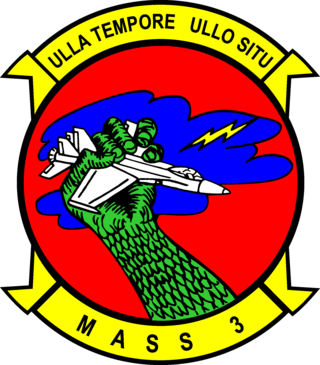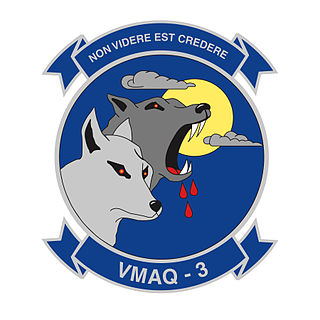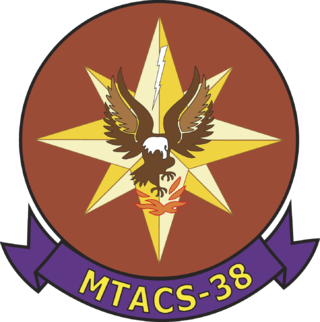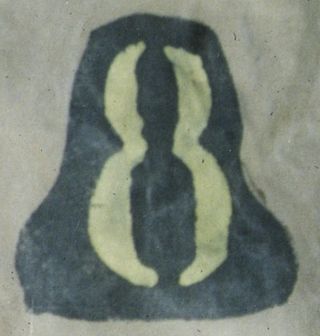
Marine Corps Air Station Yuma or MCAS Yuma is a United States Marine Corps air station. It is the home of multiple squadrons of F-35B Lightning IIs of the 3rd Marine Aircraft Wing, Marine Aviation Weapons and Tactics Squadron 1 (MAWTS-1), Marine Operational Test and Evaluation Squadron 1 (VMX-1) and Marine Fighter Training Squadron 401 (VMFT-401), an air combat adversary squadron of the 4th Marine Aircraft Wing of the Marine Corps Reserve. It is a designated Superfund site due to a number of soil and groundwater contaminants, including asbestos.

Marine Air Support Squadron 3 (MASS-3), is a United States Marine Corps aviation command and control unit that provides the Direct Air Support Center (DASC) for the 1st Marine Expeditionary Force. They are based out of the 32 Area on Marine Corps Base Camp Pendleton, California and fall under the command of Marine Air Control Group 38 and the 3rd Marine Aircraft Wing.

Marine Tactical Electronic Warfare Squadron 3 (VMAQ-3) was one of four Tactical Electronic Warfare Squadrons in the United States Marine Corps. The squadron consisted EA-6B Prowler jets and was tasked with conducting airborne electronic warfare. The squadron was based at Marine Corps Air Station Cherry Point, North Carolina and fell under the command of Marine Aircraft Group 14 (MAG-14) and the 2nd Marine Aircraft Wing. The squadron was decommissioned on May 11, 2018 as the Marine Corps sunsets the EA-6B Prowler.

Marine Air Control Squadron 1 (MACS-1) is a United States Marine Corps aviation command and control squadron. The squadron provides aerial surveillance, air traffic control, ground-controlled intercept, and aviation data-link connectivity for the I Marine Expeditionary Force. It was the first air warning squadron commissioned as part of the Marine Corps' new air warning program and is the second oldest aviation command and control unit in the Marine Corps. The squadron is based at Marine Corps Air Station Yuma and falls under Marine Air Control Group 38 and the 3rd Marine Aircraft Wing.

Marine Air Control Group 28 (MACG-28) is a United States Marine Corps aviation command and control unit based at Marine Corps Air Station Cherry Point that is currently composed of four command and control squadrons and a low altitude air defense battalion that provide the 2nd Marine Aircraft Wing with airspace coordination, air control, immediate air support, fires integration, air traffic control (ATC), radar surveillance, aviation combat element (ACE) communications support, and an integrated ACE command post in support of the II Marine Expeditionary Force.

Marine Air Control Squadron 4 (MACS-4) is a United States Marine Corps aviation command and control squadron that provides aerial surveillance, Ground-controlled interception, and air traffic control for the III Marine Expeditionary Force. Originally formed in World War II, the squadron's most notable combat operations occurred during the Vietnam War when it was the first unit to ever use the Marine Tactical Data System. They are currently based at Marine Corps Air Station Futenma and fall under the command of Marine Air Control Group 18 and the 1st Marine Aircraft Wing.

Marine Air Control Squadron 2 (MACS-2) is a United States Marine Corps aviation command and control squadron. The squadron provides aerial surveillance, Ground-controlled interception, and air traffic control for the II Marine Expeditionary Force. They are based at Marine Corps Air Station Cherry Point and fall under Marine Air Control Group 28 and the 2nd Marine Aircraft Wing.

Marine Tactical Reconnaissance Squadron 3 (VMFP-3) was an aviation unit of the United States Marine Corps active between 1975 and 1990.

Marine Tactical Air Command Squadron 38 (MTACS-38), was a United States Marine Corps aviation command and control unit that provided the Tactical Air Command Center (TACC) for the 3rd Marine Aircraft Wing. The TACC is the senior agency in the Marine Air Command and Control System (MACCS) and serves as the operational command post for the commander of the aviation combat element and their staff. The squadron was based at Marine Corps Air Station Miramar, California and fell under the command of Marine Air Control Group 38 and the 3rd Marine Aircraft Wing.

Marine Corps Air Station Cherry Point or MCAS Cherry Point is a United States Marine Corps airfield located in Havelock, North Carolina, United States, in the eastern part of the state. It was built in 1941, and was commissioned in 1942 and is currently home to the 2nd Marine Aircraft Wing.

Marine Air Control Squadron 5 (MACS-5) was a United States Marine Corps aviation command and control squadron. The squadron provided aerial surveillance and early warning while it was active from 1944 through 1993. They were last based at Marine Corps Air Station Beaufort, South Carolina and fell under the command of Marine Air Control Group 28 (MACG-28) and the 2nd Marine Aircraft Wing.

The AN/TPS-80 Ground/Air Task Oriented Radar (G/ATOR) is the United States Marine Corps next-generation Air Surveillance/Air Defense and Air Traffic Control (ATC) Radar. The mobile active electronically scanned array radar system is currently being developed by Northrop Grumman and was expected to reach initial operating capability in August 2016.

Air Warning Squadron 8 (AWS-8) was a United States Marine Corps aviation command and control unit that provided aerial surveillance and early warning of enemy aircraft during World War II. The squadron was commissioned on March 3, 1944 and was one of five Marine Air Warning Squadrons that provided land based radar coverage during the Battle of Okinawa in 1945. AWS-8, utilizing the callsign "Arsenic," remained on Okinawa as part of the garrison force following the Surrender of Japan. The squadron departed Okinawa for the United States in February 1946 and was quickly decommissioned upon its arrival in California. To date, no other Marine Corps squadron has carried the lineage and honors of AWS-8 to include Marine Air Control Squadron 8 (MACS-8).
Marine Tactical Data System, commonly known as MTDS, was a mobile, ground based, aviation command and control system developed by the United States Marine Corps for the execution of anti-air warfare in support of the Fleet Marine Force (FMF). It was the Marine Corps' first semi-automated system capable of collecting, processing, computing and displaying aircraft surveillance data while also sharing that information with other participating units via tactical data link. The system was developed in the late 1950s/early 1960s when it was recognized that due to the speed, range and complexity of fighter aircraft operations effective air control and air defense demanded enhanced situational awareness.

Marine Air Control Squadron 3 (MACS-3) was a former United States Marine Corps aviation command and control squadron. During its later years it also served as an operational test and evaluation squadron. Originally formed in World War II as Air Warning Squadron 12 (AWS-12), its original mission was to provide aerial surveillance and ground-controlled interception (GCI) for Marine Corps forces during amphibious operations. The squadron did not participate in combat operations during WWII however it did deploy and operate during the Korean War. In 1961, MACS-3 was transferred from the Fleet Marine Force to the administrative control of Air, Fleet Marine Forces Pacific in order to serve as the operational test and evaluation squadron for what was at the time, the largest research and development project in the Marine Corps - Marine Tactical Data System (MTDS). After MTDS testing was complete the Marine Corps recognized that it was not properly staffed to develop, test, and acquire new digital equipment. On 1 July 1970, MACS-3 was decommissioned and its structure and equipment were utilized to form Marine Corps Tactical Systems Support Activity (MCTSSA) at Marine Corps Base Camp Pendleton, California. Of note, MCTSSA does not carry MACS-3's lineage and honors.

Edward Steve Fris was a lieutenant general in the United States Marine Corps. He served as the Director of Aviation, Headquarters Marine Corps and is considered a pioneer in the development of today's Marine Air Command and Control System (MACCS).
Marine Aircraft Group 43 (MAG-43) was a fixed wing aviation group in the United States Marine Corps Reserve based at Naval Air Station Joint Reserve Base Willow Grove, Pennsylvania.

The AN/TPS-63 was a medium range, Two-dimensional, L band radar system utilized by the United States Marine Corps from the early 1980s until finally retired in 2018. This mobile radar was developed by Northrop Grumman and complimented the AN/TPS-59 long range radar by providing 360 degree, gap-filling coverage of low altitude areas. Because it was more mobile, the TPS-63 was also employed as the first radar ashore during amphibious operations until the larger and more capable AN/TPS-59 was established. The TPS-63 was used in combat operations during the Gulf War, the 2003 invasion of Iraq and subsequent operations in Iraq and Afghanistan. The TPS-63 was eventually phased out of service in 2018 as it was replaced by the AN/TPS-80 Ground/Air Task Oriented Radar.
Marine Air Traffic Control Units (MATCU) were United States Marine Corps air traffic control (ATC) detachments that provided continuous, all-weather, radar and non-radar, approach, departure, enroute, and tower ATC services at both garrison Marine Corps Air Stations and tactical airfields when deployed. MATCUs possessed Tactical air navigation systems (TACAN) and Ground-controlled approach (GCA) equipment which assisted Marine Corps, joint and coalition aircraft in conducting landings during inclement weather. During the Vietnam War, numerous MATCUs served throughout the I Corps Tactical region of South Vietnam supporting the III Marine Amphibious Force. Beginning in the mid-1970s, the Marine Corps decided to consolidate regionally aligned MATCUs into Marine Air Traffic Control Squadrons. The last reserve MATCU was decommissioned in 1980.

















